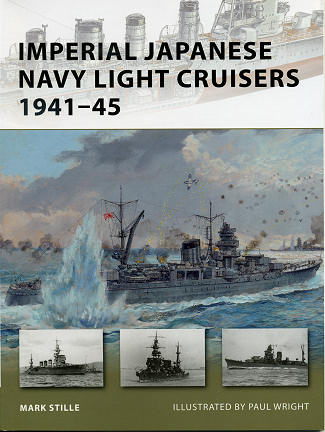Osprey's Imperial Japanese
Navy Light Cruisers 1941-45
|
Author |
MarkStille illustrated by Paul Wright |
|
Publisher/Distributor |
Osprey Publishing |
|
Price |
$17.95 MSRP |
|
Reviewer: |
Scott Van Aken
|
|
Notes: |
48 pages, 7¼ x 9¼ inches, softcover
ISBN: 978-1-84908-562-5 |
 Japan
finished WWI with a pretty strong Navy. Not like those of
Great Britain or even Imperial Germany, but one that met their needs. Like all
navies, it was important to continue to build newer ships to replace the older
ones and to modernize those that were still in the fleet to meet changing
situations. When Japan entered WWII, it had a
pretty strong navy in terms of surface forces.
Japan
finished WWI with a pretty strong Navy. Not like those of
Great Britain or even Imperial Germany, but one that met their needs. Like all
navies, it was important to continue to build newer ships to replace the older
ones and to modernize those that were still in the fleet to meet changing
situations. When Japan entered WWII, it had a
pretty strong navy in terms of surface forces.
In one area where
Japan differed tactically from other naval forces is in the use of light
cruisers. While other nations had them as part of the screening force for their
main fleet, the Japanese used light cruisers as flotilla leaders for destroyer
or submarine flotillas. This was something rather foreign to other navies of the
world, but then the Japanese had and still have a bit different way of looking
at things and it was decided that these light cruisers would hold the flotilla
staff, so needed a larger ship.
However, Japanese
destroyer construction and development outpaced most of Japan's light cruisers.
Not only were the destroyers faster than the lead ship, but they were often
equally armed. This put a bit of a strain on things until newer ships with
greater speed and armor were built to replace them. Once replaced, Japan used
those ships as fast transports, sub hunters or fleet protection.
Throughout the war,
Japan's light cruiser force played catch up in terms of equipment such as radars
and they were always considered by other nations to have inadequate anti-air
protection. It is not all that surprising that close to half lost were lost to
air action. The most lost were to submarines while only two were lost during
surface action. Two ships survived the war in good enough condition to help
repatriate Japanese soldiers before they were scrapped.
This book in the New Vanguard series
looks at the eight major classes of Japanese heavy cruisers which included the
Tenryu, Nagara, Yubari, the one off Oyodo and even the Katori class training
cruisers. Each class is provided a basic history of the ships
as well as the design and modifications made to them as time progressed. There
are a superb number of period photos of each type as well as cutaways and the
excellent artwork of Paul Wright to help us visualize what these ships were like
in action.
An excellent book on a fascinating subject and one that I am positive you will find to be of interest.
It is a book that
will be pulled from the shelves time after time and one I can highly recommend
to you.
February 2012
For more on the complete line of Osprey books,
visit www.ospreypublishing.com. In the US, it is
Osprey Direct at 44-02 23rd St, Suite 219, Long Island City, NY 11101., where you can
get a catalogue of available books.
If you would like your product reviewed fairly and quickly, please
contact
me or see other details in the Note to
Contributors.
 Japan
finished WWI with a pretty strong Navy. Not like those of
Great Britain or even Imperial Germany, but one that met their needs. Like all
navies, it was important to continue to build newer ships to replace the older
ones and to modernize those that were still in the fleet to meet changing
situations. When Japan entered WWII, it had a
pretty strong navy in terms of surface forces.
Japan
finished WWI with a pretty strong Navy. Not like those of
Great Britain or even Imperial Germany, but one that met their needs. Like all
navies, it was important to continue to build newer ships to replace the older
ones and to modernize those that were still in the fleet to meet changing
situations. When Japan entered WWII, it had a
pretty strong navy in terms of surface forces.